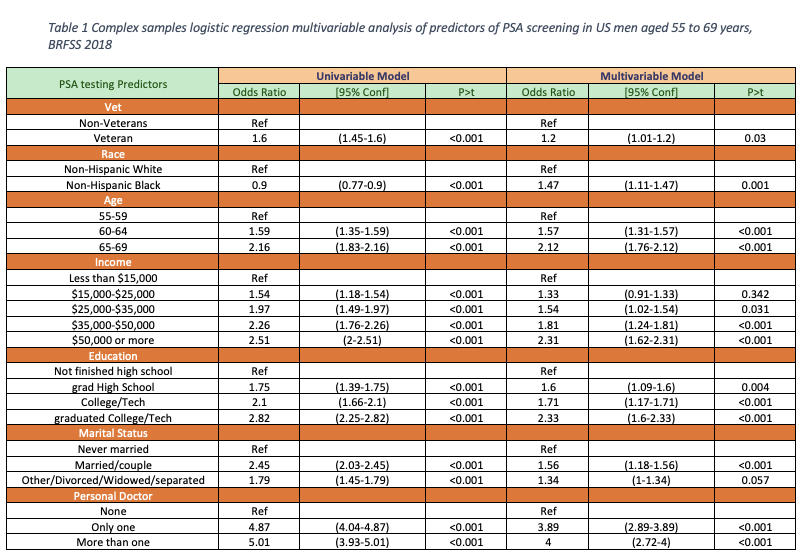Back
Poster, Podium & Video Sessions
Moderated Poster
MP58: Prostate Cancer: Detection & Screening VII
MP58-16: Does veteran status mitigate racial disparities in prostate cancer screening? Analysis of prostate-specific antigen screening patterns in the 2018 Behavioral Risk Factor Surveillance System Data
Monday, May 16, 2022
1:00 PM – 2:15 PM
Location: Room 228
Khalid Alkhatib*, Muhieddine Labban, Logan Briggs, David-Dan Nguyen, Peter Herzog, Alexander P. Cole, Boston, MA, Austin Haag, Waco, TX, Quoc-Dien Trinh, Boston, MA

Khalid Alkhatib, MD (he/him/his)
Sr. Clinical Research Fellow
University of Pennsylvania
Poster Presenter(s)
Introduction: Limited data exist on prostate cancer screening behaviors in U.S. military veterans who receive universal access to care through the Veterans Health Administration or regular civilian care facilities. We sought to analyze the effect of veteran status on prostate-specific antigen (PSA) screening to examine the effect of veteran status on receipt of prostate-specific antigen (PSA) screening and more specifically whether access to the Veterans Health System mitigates racial disparities in PSA screening.
Methods: A cross-sectional analysis of non-Hispanic White (NHW) and non-Hispanic Black (NHB) men aged 55-69 who responded to the PSA screening survey was conducted using the 2018 Behavioral Risk Factor Surveillance System data. A bivariate analysis and a complex weighted multivariable logistic regression model were used to evaluate predictors of PSA screening, including the interaction between race and veteran status. an institutional review board waiver was obtained.
Results: Screening prevalence was higher among veterans (43.2%, 95% confidence interval (CI) 41.6% - 44.9%) versus non-veterans (39.6%, 95% CI 38.66% - 40.45%), p<0.001. Among non-veterans, the prevalence of PSA screening was significantly lower in NHB (34.1%, 95% CI 31.1% - 37.1%) versus NHW (40.3%, 95% CI 39.3% - 41.2), p<0.001. Among veterans, NHB men had a significant higher screening prevalence (48.4%, 95% CI 42.9% - 53.9%) versus NHW men (42.3%, 95% CI 40.5% - 44.1), p=0.037. We found that veteran status (OR 1.1, CI 1.01 – 1.20, p=0.030) and NHB race (OR 1.28, CI 1.11 – 1.47, p<0.001) were significantly associated with receipt of PSA screening (Table 1). A significant positive interaction was found between veteran status and race (pint=0.030).
Conclusions: Veteran status and NHB race were found to be independent predictors of PSA screening. The interaction between veteran status and race suggests that access to health coverage available to veterans may mitigate racial differences in prostate cancer screening behaviors. Alternatively, differential preventive cancer screening behaviors among military health care providers may explain the differences. Further studies are needed to translate such findings into the civilian health care system.
Source of Funding: None

Methods: A cross-sectional analysis of non-Hispanic White (NHW) and non-Hispanic Black (NHB) men aged 55-69 who responded to the PSA screening survey was conducted using the 2018 Behavioral Risk Factor Surveillance System data. A bivariate analysis and a complex weighted multivariable logistic regression model were used to evaluate predictors of PSA screening, including the interaction between race and veteran status. an institutional review board waiver was obtained.
Results: Screening prevalence was higher among veterans (43.2%, 95% confidence interval (CI) 41.6% - 44.9%) versus non-veterans (39.6%, 95% CI 38.66% - 40.45%), p<0.001. Among non-veterans, the prevalence of PSA screening was significantly lower in NHB (34.1%, 95% CI 31.1% - 37.1%) versus NHW (40.3%, 95% CI 39.3% - 41.2), p<0.001. Among veterans, NHB men had a significant higher screening prevalence (48.4%, 95% CI 42.9% - 53.9%) versus NHW men (42.3%, 95% CI 40.5% - 44.1), p=0.037. We found that veteran status (OR 1.1, CI 1.01 – 1.20, p=0.030) and NHB race (OR 1.28, CI 1.11 – 1.47, p<0.001) were significantly associated with receipt of PSA screening (Table 1). A significant positive interaction was found between veteran status and race (pint=0.030).
Conclusions: Veteran status and NHB race were found to be independent predictors of PSA screening. The interaction between veteran status and race suggests that access to health coverage available to veterans may mitigate racial differences in prostate cancer screening behaviors. Alternatively, differential preventive cancer screening behaviors among military health care providers may explain the differences. Further studies are needed to translate such findings into the civilian health care system.
Source of Funding: None


.jpg)
.jpg)